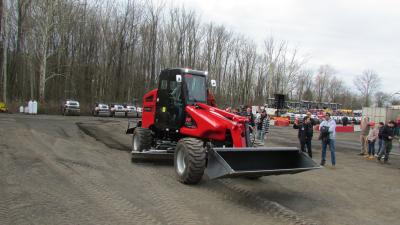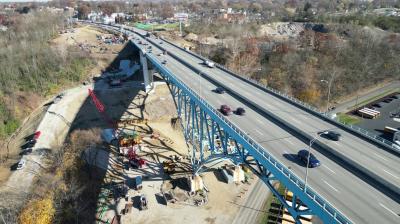The improvements of I-26 at the Ashley Phosphate Road/U.S. 52 interchange, and the widening of 3.5 mi. (5.6 km) of Ashley Phosphate Road in North Charleston, SC, began Oct. 3, 2002. The South Carolina Department of Transportation (SCDOT) accessed the need for these improvements in order to accommodate the current and projected increases in commuter traffic and the dense commercial and industrial development in the area.
The contract is currently $50 million. It is a federal-aid project with 75 percent of the funding coming from the federal government and the remainder from the state.
The prime contractor for this project is Banks Construction Company, of North Charleston, SC. The contractor for the bridge construction is United Contractors. Earthtech, located in Raleigh, NC, developed the plans in conjunction with the SCDOT and Construction Resource Management (CRM) west.
According to John R. Paulus, resident construction engineer of SCDOT, the CRM’s primary objective is to manage the delivery of a quality system of roadway, bridge and associated facilities to the department on time, within budget and with minimal disruption to the public.
Project plans include widening Ashley Phosphate Road, from Tedder Street to Dorchester Road, to three lanes in each direction with a center median, 2-ft. (.6 m) curb and gutter section, and 5-ft. (1.5 m) sidewalks. The original road had two lanes in the eastbound and westbound directions, with a designated turn lane in the median.
In the widening portion of the job, utility relocation remains the main focus. Electric lines, water and sewer mains, gas services, telephone and cable lines all must be moved to accommodate the new road.
The interchange portion of the project involves replacing and widening two interstate overpasses, the construction of a direct on/off ramp for I-26 east, and the addition of “collector-distributor” lanes serving Ashley Phosphate Road and U.S. 52 for I-26 west.
For the interstate interchange project, a temporary on-ramp from Ashley Phosphate Road to I-26 east was constructed. This allowed the removal of the old on-ramp, and construction of new bridge embankment where the old ramp had been.
The U.S. 52 overpass, also known as the 52-flyover, will be replaced with a new three-lane bridge located east of the existing two-lane structure. This new bridge will provide a designated lane for access to Ashley Phosphate Road and two through lanes to I-26 east.
Mechanically stabilized earth walls (MSE Walls) were erected at both ends of the new flyover bridge and the ends of the Ashley Phosphate Phase I bridge. In addition, the substructures, columns and caps for both bridges have been completed. This will allow the contractor to begin placing the bridge girders.
The existing five-lane Ashley Phosphate overpass will be replaced with a new ten-lane bridge. This bridge will accommodate four through lanes in each direction and two left through lanes westbound to provide access to the new I-26 east on-ramp.
A major part of this project has been the installation of the storm water drainage system, which is made up of approximately 10 mi. (16.1 km) of reinforced concrete pipe and 583 structures that allow water to access the system and the extension of three existing box culverts.
According to Paulus, this presented several unique challenges.
“The size and length of this project both required a great deal of attention to erosion control and storm water management,” he explained. The prime contractor, Banks Construction, realizing the importance that the SCDOT and FHWA puts on erosion control, dedicated a crew entirely to installation and maintenance of erosion control measures.
He added that an additional challenge has been the installation of ground modifications around existing and new drainage structures. After realizing that the ground modifications were compromising the drainage, Banks Construction, CRM West, SCDOT, FHWA and Layne Construction met with geotech consultant S&ME and developed a scheme using grout columns to protect the in-place drainage and allow the installation of the necessary VCC columns.
To address ecological concerns, an environmental assessment was prepared in January 2000 identifying endangered species, wetlands, water quality, floodplains, farmlands, cultural resources, air quality, traffic noise, displacements, social and economical impacts, and hazardous materials.
It was determined that there was a large area of high-level contamination at the east end of the Ashley Phosphate overpass. Additional precautions were taken in this area, and ground water was continuously monitored during the drainage installation and ground modifications to ensure that the contamination did not migrate outside the existing limits.
Careful consideration also was given to traffic control and flow both in regards to current conditions and those in the future.
“It is critical to the success of this project to minimize the impact to the traveling public, existing businesses and neighboring communities,” Paulus said.
To handle traffic during construction, phasing of construction activities were developed to provide a “Level of Service” (LOS) at or above what exited prior to starting the project. Lane closures between 6 a.m. and 8 p.m. were prohibited on this project, prompting the contractor to do a majority of the Phase I work during the night hours. Once this was completed, traffic was shifted to the new pavement and the contractor was able to continue the widening of Phase II as a daytime operation.
LOS is determined using conditions such as speed, travel time, freedom to maneuver, traffic interruptions, delay, and safety. Level of service represents the best operating conditions, and LOS F represents the worst operating conditions.
Ashley Phosphate in year 2000 operated at LOS D. With additional through lanes, Ashley Phosphate Road is anticipated to operate at LOS D and E in 2025. Without improvements, the entire road would have been operating at a LOS F by the year 2025.
Paulus added that because the area is located in an urban area, there were a few “unique” challenges, included concerns about right-of-way.
“Added to the challenge of limited right of way, is the number of sub-contractors and utility companies that are working in this area,” he said. “Partnering, however, has played a major role in the co-ordination of the work and the overall success of the project.”
The completion date is set for Sept. 14, 2005.
Today's top stories















